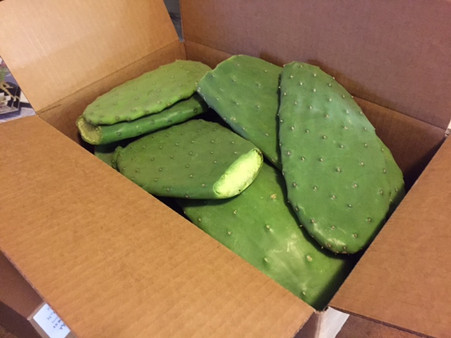- Home
- Food Items
- Cactus Pads (by the pound)
Product Reviews
Description
We believe prickly pear cactus pads to be one of the best food items for all tortoise species (especially grassland species). It is high in calcium and fiber while being low in protein and fats. Opuntia has a long shelf life compared to most produce, and is not wet on the exterior, so it doesn't stick to the substrate like many vegetables and fruits do. It is best kept in the refrigerator after arrival, and can keep several weeks (or until it starts to look bad). Eventually, the pads will begin to wrinkle, but they're still perfectly usable. For baby tortoises, we slice it into strips about 1/4" wide. Adults can eat the pads whole.
Our cactus is grown on our land here in Las Vegas, and cut from the plant after the order comes in (as fresh as they get).
For re-planting, we prefer to use thicker, larger pads. They are easily grown by simply burying the pads standing upright with the bottom 1/3 buried in the ground. It often takes several months to a year for much growth (new pads) to begin. This is the reason we prefer thicker pads for planting, because they can stand freely for longer, while thinner pads will get soft and lean over. Once they are started and roots are developed, they are quite fast growing plants. Almost all growth happens during the warmer months, and our plants do well outdoors year round here in Vegas. Low temperatures below about 22 degrees can cause damage to the thinner/younger pads, but the root plant will usually survive down to about 15 degrees (on an established plant). Brand new plants should be protected from extreme cold for the first winter or two (wrapping in burlap, etc).
*Being a cactus, our opuntia does have some small spines remaining, so please be careful while handling them. Tortoises do not have a problem eating these spines (they eat worse naturally), but they can stick human fingers if care is not taken. If you want to try to remove the spines, rubbing them with an old sponge in a circular pattern usually gets most of them out.
*Our exact variety is opuntia ficus indica (elephant ear). We will eventually have nopalea grande available also which is a brighter green color and has fewer spines, but is less cold hardy. We cut cactus about once a week so we can do a big batch all at once, so occasionally an order including cactus will be delayed a few days or a week waiting for the next batch.
 Loading... Please wait...
Loading... Please wait...

